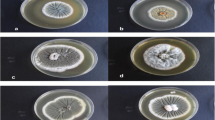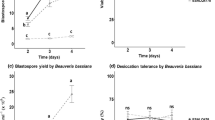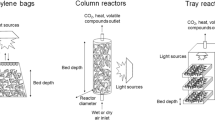Abstract
Isaria fumosorosea frequently causes mycosis of agricultural pests in the hot semiarid and dry tropical regions of Mexico. Because temperature tolerance restricts the use of fungal biopesticides, we investigated two isolates from these areas for possible development into mycoinsecticides for use in hot weather agricultural zones. We studied the effects of culture system (solid or submerged cultures) and temperature on the fungal growth, extracellular enzyme production, pathogenicity, and thermotolerance of the produced propagules. Between 20 and 28 °C, the specific growth rates of the isolate PCC were higher on solid media, but in the submerged culture, the isolate P43A grew faster even at temperatures of up to 34 °C. On solid media, P43A produced 1.5-fold more proteases than PCC, but in the submerged culture, both strains had similar activities. Under the same culture conditions, PCC produced a blastospore:conidia ratio of 1:2, and P43A produced a ratio of 1:5. PCC aerial conidia had the shortest Lethal Time 50 (LT50, the time to reach 50 % mortality) against Galleria mellonella larvae, but LT50 was equal for the aerial conidia and the submerged propagules of P43A and PCC. The submerged and aerial propagules of P43A were more thermotolerant than those of PCC. Each isolate performed differently in each culture system, and we concluded that the intended production method should be included as a criterion for screening of entomopathogenic fungus. We found that thermotolerance is a specific characteristic of an isolate from a given species. Because of its specific characteristics, P43A shows more promise for the development of a submerged conidia-based mycoinsecticide for foliar application in aqueous form in hot climate regions.


Similar content being viewed by others
References
Ali S, Huang Z, Ren S (2009) Media composition influences on growth, enzyme activity, and virulence of the entomopathogen hyphomycete Isaria fumosoroseus. Entomol Exp Appl 13:30–38. doi:10.1111/j.1570-7458.2009.00833.x
Ali S, Huang Z, Ren S (2010) Production of cuticle degrading enzymes by Isaria fumosorosea and their evaluation as biocontrol agent against diamondback moth. J Pest Sci 83:361–370. doi:10.1007/s10340-010-0305-6
Asaff A, Cerda-García-Rojas CM, Viniegra-González G, de la Torre M (2006) Carbon distribution and redirection of metabolism in Paecilomyces fumosoroseus during solid-state and liquid fermentations. Process Biochem 4:1303–1310. doi:10.1016/j.procbio.2006.01.001
Bateman R, Carey M, Batt D, Prior C, Abraham Y, Moore D, Jenkins N, Fenlon J (1996) Screening for virulent isolates of entomopathogenic fungi against the desert locust, Schistocerca gregaria (Forskål). Biocontrol Sci Tech 6:549–560
Berekaa MM, Zaghloul TI, Abdel-Fattah YR, Saeed HM, Sifour M (2009) Production of a novel glycerol-inducible lipase from thermophilic Geobacillus stearothermophilus strain-5. World J Microbiol Biotechnol 25:287–294. doi:10.1007/s11274-008-9891-3
Brand D, Soccol CR, Sabu A, Roussos S (2010) Production of fungal biological control agents through solid state fermentation: a case study on Paecilomyces lilacinus against root-knot nematodes. Micol Appl Int 22:31–48
Cabanillas HE, Jones WA (2009) Effects of temperature and culture media on vegetative growth of an entomopathogenic fungus Isaria sp. (Hypocreales: Clavicipitaceae) naturally affecting the whitefly. Bemisia tabaci in Texas. Mycopathologia 167:263–271. doi:10.1007/s11046-008-9176-2
Cliquet S, Jackson MA (2005) Impact of carbon and nitrogen nutrition on the quality, yield and composition of blastospores of the bioinsecticidal fungus Paecilomyces fumosoroseus. J Ind Microbiol Biotechnol 32:204–210. doi:10.1007/s10295-005-0232-3
de Faria MR, Wraight SP (2007) Mycoinsecticides and Mycoacaricides: a comprehensive list with worldwide coverage and international classification of formulation types. Biol Control 43:237–256. doi:10.1016/j.biocontrol.2007.08.001
El-Sayed GN, Ignoffo CM, Leathers TD, Gupta SC (1993) Effects of cuticle source and concentration on expression of hydrolytic enzymes by an entomophatogenic fungus, Nomuraea rileyi. Mycopathologia 122:149–152
Esteves I, Peteira B, Powers S, Magan N, Kerry BR (2009) Effects of osmotic and matric potential on radial growth and accumulation of endogenous reserves in three isolates of Pochonia chlamydosporia. Biocontrol Sci Tech 19:185–199. doi:10.1080/09583150802650175
Fargues J, Bon MC (2004) Influence of temperature preferences of two Paecilomyces fumosoroseus lineages on their co-infection pattern. J Invertebr Pathol 87:94–104. doi:10.1016/j.jip.2004.07.001
Fernandes ÉKK, Bittencourt VREP, Roberts DW (2012) Perspectives on the potential of entomopathogenic fungi in biological control of ticks. Exp Parasitol 130:300–305. doi:10.1016/j.exppara.2011.11.004
García-Carreño FL, Hernández-Cortés MP, Haard NF (1994) Enzymes with peptidase and proteinase activity from the digestive systems of a freshwater and a marine decapot. J Agric Food Chem 42:1456–1461. doi:10.1021/jf00043a013
Gusev NB, Bogatcheva NV, Marston SB (2002) Structure and properties of small heat shock proteins (sHsp) and their interaction with cytoskeleton proteins. Biochem Moscow 67:613–623
Hankin L, Anagnostakis SL (1975) The use of solid media for detection of enzyme production by fungi. Mycologia 67:597–607
Hegedus DD, Khachatourians GG (1988) Production of an extracellular lipase by Beauveria bassiana. Biotechnol Lett 10:637–642
Howard AFV, N′Guessan R, Koenraadt CJM, Asidi A, Farenhorst M, Akogbéto M, Knols BGJ, Takken W (2011) First report of the infection of insecticide-resistant malaria vector mosquitoes with an entomopathogenic fungus under field conditions. Malar J 10:1–8
Imoulan A, Alaoui A, El Meziane A (2011) Natural occurrence of soil-borne entomopathogenic fungi in the Moroccan Endemic forest of Argania spinosa and their pathogenicity to Ceratitis capitata. World J Microbiol Biotechnol 27:2619–2628. doi:10.1007/s11274-011-0735-1
Jackson MA, Dunlap CA, Jaronski ST (2010) Ecological considerations in producing and formulating fungal entomopathogens for use in insect biocontrol. Biocontrol 55:129–145. doi:10.1007/s10526-009-9240-y
Jaronski ST (2010) Ecological factors in the inundative use of fungal entomopathogens. Biocontrol 55:159–185. doi:10.1007/s10526-009-9248-3
Kalbfleisch JG (1985) Probability and statistical inference II. Springer, New York
Lacey LA, Wraight SP, Kirk AA (2008) Entomopathogenic fungi for control of Bemisia tabaci biotype B: foreign exploration, research and implementation. Prog Biol Control 4:33–69
Miyashira CH, Tanigushi DG, Gugliotta AM, Santos DYAC (2010) Comparison of radial growth rate of the mutualistic fungus of Atta sexdens rubropilosa forel in two culture media. Braz J Microbiol 41:506–511
Montesinos-Matías R, Viniegra-González G, Alatorre-Rosas R, Loera O (2011) Relationship between virulence and enzymatic profiles in the cuticle of Tenebrio molitor by 2-deoxy-d-glucose-resistant mutants of Beauveria bassiana (Bals.) Vuill. World J Microbiol Biotechnol 27:2095–2102. doi:10.1007/s11274-011-0672-z
Moura Mascarin G, Batista Alves S, Biaggioni Lopes R (2010) Culture media selection for mass production of Isaria fumosorosea and Isaria farinosa. Braz Arch Biol Technol 53:753–761
Muñoz GA, Agosin E, Cotoras M, Martin RS, Volpe D (1995) Comparison of aerial and submerged spore properties for Trichoderma harzianum. FEMS Microbiol Lett 125:63–69
Nieto TP, Ellis AE (1986) Characterization of extracellular metallo- and serine-proteases of Aeromonas hydrophila strain B51. J Gen Microbiol 132:1975–1979. doi:10.1099/00221287-132-7-1975
Papagianni M, Nokes SE, Filer K (2001) Submerged and solid-state phytase fermentation by Aspergillus niger: effects of agitation and medium viscosity on phytase production, fungal morphology and inoculum performance. Food Technol Biotech 39:319–326
Pogori N, Cheikhyoussef A, Xu Y, Wang D (2008) Production and biochemical characterization of an extracellular lipase from Rhizopus chinensis CCTCC M201021. Biotechnology 7:710–717
Rangel DEN, Braga GUL, Anderson AJ, Roberts DW (2005) Variability in conidial thermotolerance of Metarhizium anisopliae isolates from different geographic origins. J Invertebr Pathol 88:116–125
Rodríguez-Gómez OL, Saucedo-Castañeda G, Viniegra-González G (2009) Substrate influence on physiology and virulence of Beauveria bassiana acting on larvae and adults of Tenebrio molitor. World J Microbiol Biotechnol 25:513–518. doi:10.1007/s11274-008-9917-x
Shoaib F, Feng-Liang J, Shun-Xiang R (2011) Determination of genetic variability among the isolates of Metarhizium anisopliae var. anisopliae from different geographical origins. World J Microbiol Biotechnol 27:359–370. doi:10.1007/s11274-010-0466-8
St. Leger RJ, Joshi L, Roberts DW (1997) Adaptation of proteases and carbohydrases of saprophytic, phytopathogenic and entomopathogenic fungi to the requirements of their ecological niches. Microbiology 143:1983–1992
Tefera T, Pringle KL (2003) Effect of exposure method to Beauveria bassiana and conidia concentration on mortality, mycosis, and sporulation in cadavers of Chilo partellus (Lepidoptera: Pyralidae). J Invertebr Pathol 84:90–95
Thomas KC, Khachatourians GG, Ingledew WM (1987) Production and properties of Beauveria bassiana conidia cultivated in submerged culture. Can J Microbiol 33:12–20
Valadares-Inglis MC, Azevedo JL (1997) Amylase and protease secretion in recombinant strains of Metarhizium anisopliae var. anisopliae following parasexual crosses. Brazil J Genet 20:171–175
Vega FE, Jackson MA, Mercadier G, Poprawski TJ (2003) The impact of nutrition on spore yields for various fungal entomopathogens in liquid culture. World J Microbiol Biotechnol 19:363–368
Vidal C, Fargues J, Lacey LA, Jackson MA (1998) Effect of various liquid culture media on morphology, growth, propagule production, and pathogenic activity to Bemisia argentifolii of the entomopathogenic Hyphomycete, Paecilomyces fumosoroseus. Mycopathologia 143:33–46
Viniegra-González G, Favela-Torres E, Aguilar CN, Rómero-Gomez SJ, Díaz-Godínez G, Augur C (2003) Advantages of fungal enzyme production in solid state over liquid fermentation systems. Biochem Eng J 13:157–167
Wang C, Hu G, St Leger RJ (2005) Differential gene expression by Metarhizium anisopliae growing in root exudate and host (Manduca sexta) cuticle or hemolymph reveals mechanisms of physiological adaptation. Fungal Genet Biol 42:704–718
Wraight SP, Inglis GD, Goettel MS (2007) Overview of pathogen groups: Fungi. In: Lacey LA, Kaya HK (eds) Field manual of techniques in invertebrate pathology, 2nd edn. Springer, Dordrecht, pp 223–248
Yeo H, Pell JK, Alderson PG, Clark SJ, Pye BJ (2003) Laboratory evaluation of temperature effects on the germination and growth of entomopathogenic fungi and on their pathogenicity to two aphid species. Pest Manag Sci 59:156–165. doi:10.1002/ps.622
Ying SH, Feng MG (2006) Medium components and culture conditions affect the thermotolerance of aerial conidia of fungal biocontrol agent Beauveria bassiana. Lett Appl Microbiol 43:331–335. doi:10.1111/j.1472-765X.2006.01947.x
Zibaee A, Sadeghi-Sefidmazgi A, Fazeli-Dinan M (2011) Properties of a lipase produced by Beauveria bassianna: purification and biochemical studies. Biocontrol Sci Techn 2:317–331. doi:10.1080/09583157.2010.548595
Acknowledgments
We thank the Department of Chemical Engineering at the University of Sonora and the PROMEP UNISON-279 for supporting this work.
Author information
Authors and Affiliations
Corresponding author
Rights and permissions
About this article
Cite this article
Esther, CP., Erika, AS., Rosa María, MC. et al. Performance of two isolates of Isaria fumosorosea from hot climate zones in solid and submerged cultures and thermotolerance of their propagules. World J Microbiol Biotechnol 29, 309–317 (2013). https://doi.org/10.1007/s11274-012-1184-1
Received:
Accepted:
Published:
Issue Date:
DOI: https://doi.org/10.1007/s11274-012-1184-1




